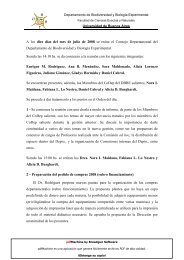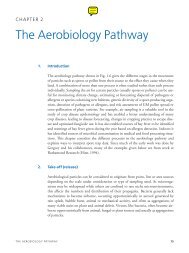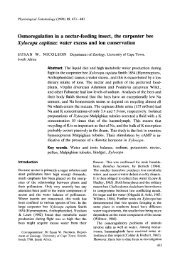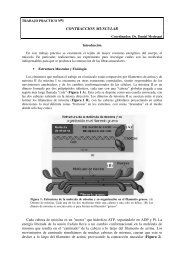Role of WUSCHEL in Regulating Stem Cell Fate in the Arabidopsis Shoot Meristem
Role of WUSCHEL in Regulating Stem Cell Fate in the Arabidopsis Shoot Meristem
Role of WUSCHEL in Regulating Stem Cell Fate in the Arabidopsis Shoot Meristem
Create successful ePaper yourself
Turn your PDF publications into a flip-book with our unique Google optimized e-Paper software.
<strong>Cell</strong><br />
812<br />
<strong>the</strong> WUS expression pattern suggests that both meristems<br />
are <strong>in</strong> part organized differently.<br />
<strong>Role</strong> <strong>of</strong> WUS dur<strong>in</strong>g Embryonic <strong>Shoot</strong><br />
<strong>Meristem</strong> Initiation<br />
The expression <strong>of</strong> WUS <strong>in</strong> <strong>the</strong> 16-cell embryo demonstrates<br />
that <strong>the</strong> shoot meristem orig<strong>in</strong>ates dur<strong>in</strong>g early<br />
embryonic pattern<strong>in</strong>g long before it can be recognized<br />
histologically (Figure 7). Our data show that at this stage,<br />
cell type differences along <strong>the</strong> apical-basal as well as<br />
<strong>the</strong> radial (<strong>in</strong>ner vs. outer cell layers) axes are already<br />
established and that WUS expression responds to <strong>the</strong>se<br />
differences.<br />
The subsequent changes <strong>in</strong> <strong>the</strong> WUS expression pattern<br />
<strong>in</strong>dicate that embryonic shoot meristem formation<br />
is a prolonged dynamic process (Figure 7), <strong>the</strong> earliest<br />
step <strong>of</strong> which may be <strong>the</strong> <strong>in</strong>itiation <strong>of</strong> a group <strong>of</strong> cells<br />
able to specify stem cells. By asymmetric cell divisions,<br />
this ability becomes progressively directed to its prospective<br />
doma<strong>in</strong> <strong>of</strong> function <strong>in</strong> <strong>the</strong> embryonic shoot meristem<br />
primordium. Dur<strong>in</strong>g this process, WUS could primarily<br />
act <strong>in</strong> <strong>the</strong> WUS-express<strong>in</strong>g cells <strong>the</strong>mselves, for<br />
example shield<strong>in</strong>g <strong>the</strong>m aga<strong>in</strong>st differentiation. Alternatively,<br />
<strong>the</strong>se cells could already function <strong>in</strong> a manner<br />
similar to <strong>the</strong> situation <strong>in</strong> active meristems from <strong>the</strong><br />
earliest embryo stages on, conferr<strong>in</strong>g to overly<strong>in</strong>g neighbors<br />
a pluripotent state. However, although <strong>in</strong> part also<br />
derived from <strong>the</strong> early WUS-express<strong>in</strong>g cells, <strong>the</strong> cotyledons<br />
are not affected <strong>in</strong> wus mutants (Laux et al., 1996).<br />
Likewise, <strong>the</strong> onset <strong>of</strong> STM expression <strong>in</strong> descendants<br />
<strong>of</strong> <strong>the</strong> early WUS-express<strong>in</strong>g cells does not require WUS<br />
Figure 7. Dynamics <strong>of</strong> <strong>the</strong> WUS Expression Pattern dur<strong>in</strong>g Early activity. These two observations <strong>in</strong>dicate that, although<br />
Embryogenesis WUS is expressed very early <strong>in</strong> embryogenesis, its re-<br />
Schematic representation <strong>of</strong> <strong>the</strong> WUS expression pattern at different quirement is restricted to <strong>the</strong> development <strong>of</strong> <strong>the</strong> proembryo<br />
stages (left panel) and a diagram <strong>of</strong> <strong>the</strong> asymmetric cell<br />
posed organiz<strong>in</strong>g center and <strong>the</strong> specification <strong>of</strong> stem<br />
divisions that lead to <strong>the</strong> localization <strong>of</strong> <strong>the</strong> WUS doma<strong>in</strong> at <strong>the</strong> base<br />
cells.<br />
<strong>of</strong> <strong>the</strong> shoot meristem primordium. WUS expression (red) is <strong>in</strong>itiated<br />
<strong>in</strong> <strong>the</strong> four subepidermal cells <strong>of</strong> <strong>the</strong> apical embryo region at <strong>the</strong> Asymmetric cell division is a well-known mechanism<br />
16-cell stage. These cells divide longitud<strong>in</strong>ally, but only <strong>the</strong> central to establish different cell fates. For example, <strong>in</strong> <strong>the</strong> C.<br />
daughter cells cont<strong>in</strong>ue WUS expression. Two mechanisms are de- elegans embryo, asymmetric localization <strong>of</strong> <strong>the</strong> PIE-1<br />
picted: <strong>in</strong>itially all daughter cells <strong>in</strong>herit WUS mRNA, which is subse- prote<strong>in</strong> marks <strong>the</strong> germl<strong>in</strong>e precursor cells and prevents<br />
quently degraded <strong>in</strong> <strong>the</strong> peripheral daughter cells, whereas <strong>the</strong> cen<strong>the</strong>ir<br />
differentiation (Mello et al., 1996). In <strong>the</strong> Arabitral<br />
daughters susta<strong>in</strong> WUS expression. Alternatively, WUS mRNA<br />
dopsis root meristem, <strong>the</strong> asymmetric divisions estabcould<br />
already be distributed asymmetrically before cell division and<br />
thus would be <strong>in</strong>herited by only one daughter cell. WUS-express<strong>in</strong>g lish<strong>in</strong>g endodermal and cortical cell layers from one set<br />
cells eventually divide horizontally, sett<strong>in</strong>g up <strong>the</strong> L2 and L3 cell <strong>of</strong> <strong>in</strong>itial cells require <strong>the</strong> activity <strong>of</strong> <strong>the</strong> SCARECROW<br />
layers at <strong>the</strong> late heart stage. In this case, WUS expression is con- gene, which is expressed <strong>in</strong> <strong>the</strong> <strong>in</strong>itials and <strong>the</strong>ir end<strong>of</strong><strong>in</strong>ed<br />
to <strong>the</strong> basal daughter cells. The orientation <strong>of</strong> <strong>the</strong> follow<strong>in</strong>g dermal daughters (Di Laurenzio et al., 1996). The dycell<br />
division is <strong>in</strong>dicated by broken l<strong>in</strong>es.<br />
namic pattern <strong>of</strong> WUS expression is <strong>in</strong>trigu<strong>in</strong>g <strong>in</strong> this<br />
context, because it may exemplify a more general strategy<br />
<strong>of</strong> how plant embryos direct a specific cell type to<br />
Differences <strong>in</strong> <strong>the</strong> Organization <strong>of</strong> <strong>Shoot</strong><br />
its appropriate position, s<strong>in</strong>ce cell migration, which<br />
and Floral <strong>Meristem</strong>s<br />
plays an important role <strong>in</strong> animal embryogenesis, is pre-<br />
In contrast to <strong>in</strong>determ<strong>in</strong>ate shoot meristems, floral mercluded<br />
<strong>in</strong> plants.<br />
istems term<strong>in</strong>ate due to <strong>the</strong> recruitment <strong>of</strong> <strong>the</strong> central<br />
cells for organogenesis. This step is preceded by a<br />
downregulation <strong>of</strong> WUS expression, consistent with a Conclusions<br />
role <strong>of</strong> WUS-express<strong>in</strong>g cells <strong>in</strong> conferr<strong>in</strong>g stem cell fate. The analysis <strong>of</strong> <strong>the</strong> WUS gene leads to novel concepts<br />
It is <strong>in</strong>terest<strong>in</strong>g to note, however, that <strong>in</strong> floral meristems <strong>of</strong> how meristems are formed and ma<strong>in</strong>ta<strong>in</strong>ed <strong>in</strong> plant<br />
WUS expression is shifted up by one cell layer <strong>in</strong> com- development. Our data <strong>in</strong>dicate that <strong>the</strong> formation <strong>of</strong> a<br />
parison to vegetative and <strong>in</strong>florescence meristems. shoot meristem is <strong>the</strong> outcome <strong>of</strong> a successive pat-<br />
Thus, although <strong>in</strong>determ<strong>in</strong>ate shoot meristems and detern<strong>in</strong>g process <strong>in</strong>itiated very early <strong>in</strong> embryo developterm<strong>in</strong>ate<br />
floral meristems are thought to be homolo- ment. Once <strong>the</strong> shoot meristem is established, WUS<br />
gous structures and share regulatory mechanisms (En- expression def<strong>in</strong>es a group <strong>of</strong> cells that function to specdrizzi<br />
et al., 1996; Laux et al., 1996; Clark et al., 1997), ify overly<strong>in</strong>g neighbors as stem cells.


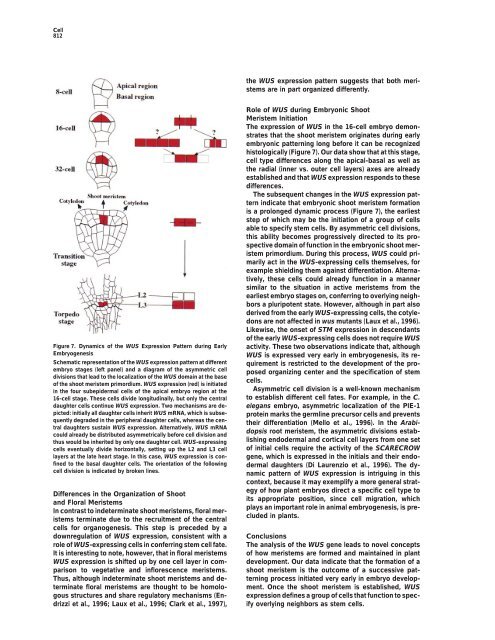
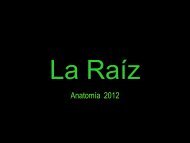
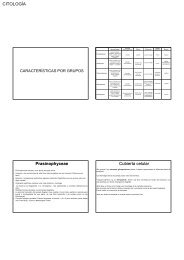


![Estructuras secretoras internas [4.64 MB]](https://img.yumpu.com/14294979/1/190x143/estructuras-secretoras-internas-464-mb.jpg?quality=85)
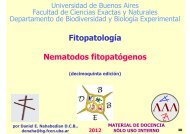
![anatomía y exomorfología [7.14 MB]](https://img.yumpu.com/12744163/1/190x143/anatomia-y-exomorfologia-714-mb.jpg?quality=85)
